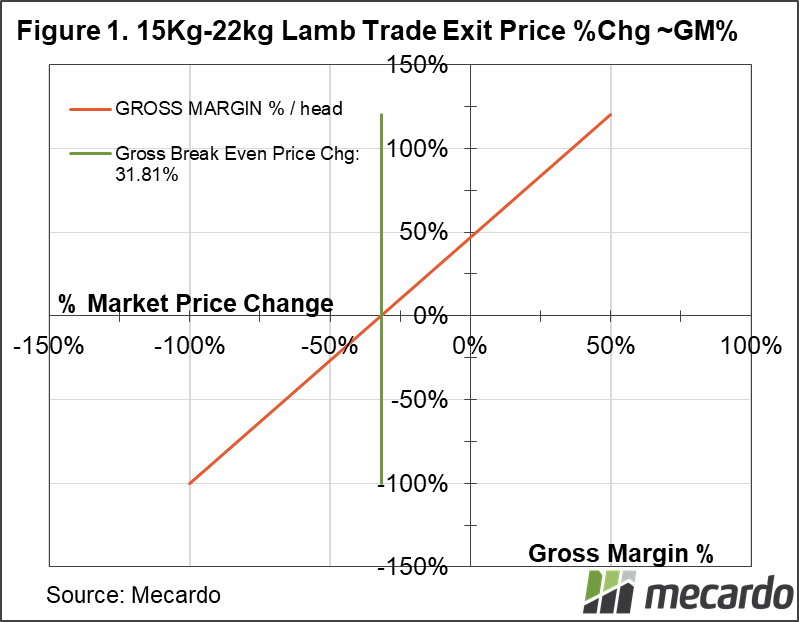Today, we look at a pretty typical lamb trading scenario that most producers would be familiar with- Buying lambs at 15kg cwt, growing them out to 22kg cwt, then turning them off at the saleyards, or over the hooks, and how the ‘breakeven rainbow’ can be used to consider risk.
Conditions are good at the moment, with solid rainfall producing lush green pastures and sizable crops, the stubble of which will be just begging for a hungry mouth to mow down post harvest. Buying in Oct/Nov when prices historically soften, and turning off in the new year is a pretty typical strategy. However, the direction of lamb prices has never looked more volatile or uncertain, so how much risk exposure is present at the moment, and how far can the market price move before the trade becomes unprofitable?
Firstly, we need to make a few general assumptions. Timing is important when considering your trading strategy. Under good conditions, a well bred lamb can put on 250g/day liveweight, which translates to roughly 112g/day cwt. For a young lamb to grow from 15kgs cwt (~33kg lwt) to trade lamb specification, of 22kg cwt (~49kgs lwt), it could take as little as 61 days before turnoff. Poorer performing lambs on less abundant pasture may take a lot longer though. Know your property, and choose lambs wisely.
Gross margin break even point can be calculated by dividing target weight gain by the exit weight. In this case, it’s the market falling -32% before gross margin goes negative on the trade. Consider (figure 1), that shows the linear relationship between % gross margin on exit you can achieve if the market moves your way – or not – over your holding and growing period.
Gross margin ignores the costs of the trade though- including transport to market, maintenance, and feed, whether it’s grain in a feedlot, or the cost of sowing and financing pasture- grass and labour cannot be treated as free. Net margin includes this, and indicates how much money you really have made on the trade. Each enterprise will have unique costs of holding and feeding lambs. Pastoral systems on the lower end, and feedlots on the higher.
The important thing about Net margin, is that the higher your holding and feeding costs are as a percentage of your lamb buy cost, the higher your break even point will naturally be, so if the market goes the wrong way, you have less headroom before booking a painful loss. (Figure 2), the “breakeven rainbow” highlights this, Notice how if lamb prices are high, you can afford for the market to fall by a larger percentage over your trade period. Consider entry with $6/ cwt lambs. The black line represents a feedlot operation with high $30/head feed costs- if the market falls 10% by exit, a loss would be suffered. In contrast, the pastoralist with $10/head holding costs won’t lose on the trade till the market has sunk 25% below the entry price for the lambs.
Enough graphs, lets put some numbers against a trade as an example. The process of fattening and growing light lambs to trade weight is a volume game- you should have close to 50% more meat per lamb to sell at turnoff time, which means that there is quite a bit of protection from price falls baked into the strategy, this is shown by the price and volume variance components of the gross margin.
Note that a 15% fall in the market in this scenario is by no means catastrophic, and good gross margins can still be generated regardless, while lifts are magnified by the fact that the lamb is a lot heavier than when you started out with. It’s a two edged sword though; picking a mob with bad genes, or getting nutrition wrong will mean longer to turnoff time, higher feed costs, and more exposure to price risk as a result.
What does it mean?
The market looks quite uncertain at the moment as to where it might go next year. Think about your risk appetite and your potential exposure to downside (and upside!) when considering making lamb trades in the coming spring season. Calculate your enterprise’s net margin breakeven point, and pit that against your view of the market. The math says that, in general, the higher the price lambs are, on entry into a lamb trade, the higher a % fall you can sustain before booking a loss, and that the higher your holding and feeding costs, the less robust your trade will be to downside.
Have any questions or comments?
Key Points
- In good conditions, a well bred young lamb can gain 250g/day lwt, or 112g/day cwt if we assume a 45% dressing percentage.
- Price risk comes from the market, volume risk lies in the ability for the lambs to grow adequately.
- Knowing your Net margin breakeven points can be a good yardstick for managing risk
Click on figure to expand
Click on figure to expand
Click on table to expand
Data sources: MLA, Mecardo














